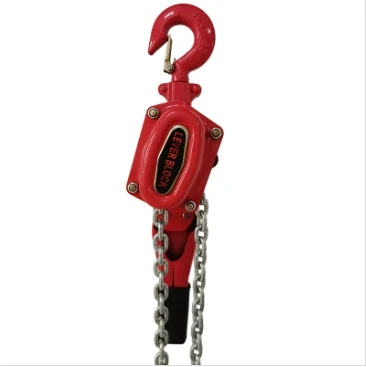Lever blocks, commonly known as lever hoists, have become essential tools in various industries where heavy-duty lifting and precise maneuvering of heavy loads are routine tasks. To truly appreciate their importance and versatility, one must delve into the intricacies of their design, functionality, and the practical applications that showcase their unmatched potential.

A lever block is a robust and portable lifting device operated manually, relying on a simple mechanical advantage to hoist heavy objects. Its ingenious design features a lever handle, heavy-duty hooks, a chain adhered to safety standards, and a ratchet and pawl system. This engineering marvel ensures controlled lifting, lowering, and positioning of loads with remarkable precision. Its compact size and portability make it an invaluable tool for varied environments, from construction sites and shipyards to warehouses and workshops.
The types of lever blocks available in the market cater to diverse lifting capacities and operational needs. Generally, they range from models that can lift a few hundred kilograms to industrial-grade ones handling several tons. Selecting the correct model requires understanding the specific demands of the task at hand, thus ensuring both efficiency and safety in operations. The choice of a lever block should primarily depend on the maximum weight requirement, the frequency of use, and the operating conditions.

One of the key advantages of lever blocks is their simplicity and ease of use. Their straightforward mechanism demands minimal training, allowing even novice users to operate them safely and efficiently after a brief orientation. This aspect makes them preferable over more complex machinery, especially in settings where quick and flexible lifting solutions are necessary. Additionally, the minimal maintenance requirements and durable construction assure long-term reliability, reducing downtime due to equipment failure.
Industry professionals laude lever blocks for their adaptability in confined spaces, where larger lifting equipment would prove cumbersome. Their capability to work in various angles without requiring a straight vertical pull further elevates their utility. This flexibility is crucial in settings like underground mines, ship maintenance, and railway projects, where conventional lifting equipment may not suffice.
lever block
Safety remains a top priority when employing lever blocks. Adhering to the manufacturer's guidelines for load limits and regular inspection routines is imperative to ensure the safety of personnel and integrity of the equipment. Routine checks for signs of wear and tear, such as stretched chains or damaged hooks, prevent accidents and unforeseeable downtimes. Implementing a preventive maintenance schedule not only extends the life of the lever block but also bolsters trust within the workforce using the equipment daily.
Lever blocks also sit at an intersection of traditional and modern lifting techniques. While they employ classic mechanical principles, recent innovations have introduced ergonomic designs and improved materials that enhance their performance and user experience. Manufacturers continually refine these devices to adapt to evolving safety standards and operational challenges, reinforcing their status as a must-have tool in many professional arenas.
The reverence for lever blocks is not solely limited to their mechanical prowess but also extends to their economic value. They represent an affordable alternative to more sophisticated lifting machines without compromising on function and reliability. For businesses aiming to optimize operational costs without sacrificing quality and safety, investing in a high-quality lever block makes pragmatic sense.
In conclusion, lever blocks epitomize a perfect blend of simplicity, reliability, and versatility, embodying a legacy of mechanical ingenuity that continuously proves indispensable across various industries. Their unmatched ability to maneuver heavy loads with precision in diverse environments underscores their irreplaceable role in modern lifting operations. As industries evolve, the lever block will undoubtedly continue to adapt, safeguarding its relevance and indispensability in the realm of material handling.








